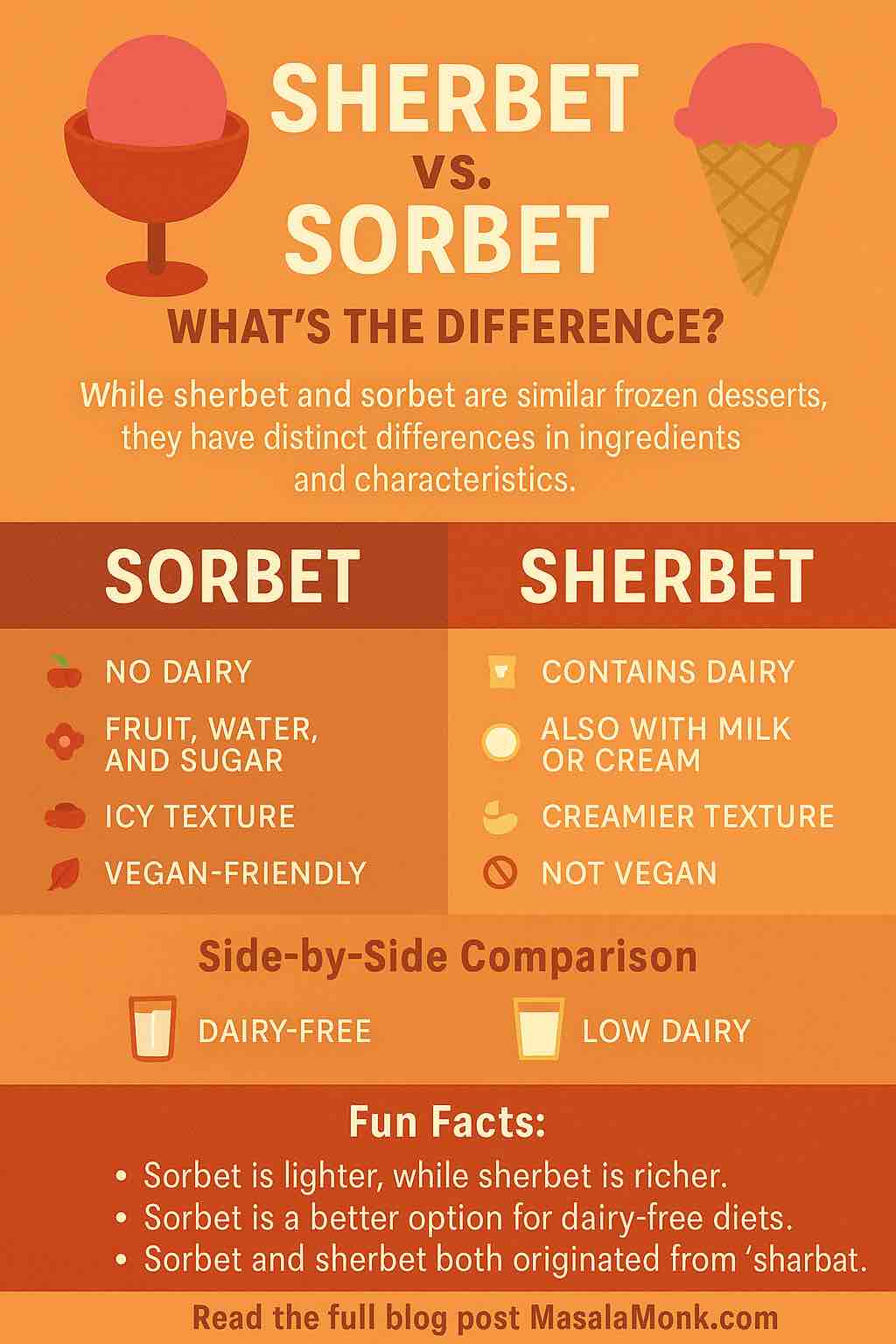
Understanding These Frozen Treats the Masala Monk Way
If you’ve ever stood frozen (pun intended) in front of a dessert counter, puzzled over whether to choose sherbet or sorbet, you’re not alone. These two icy desserts may look similar, but their ingredients, texture, taste, and even cultural history tell a story of their own.
At Masala Monk, where flavor meets tradition, we believe understanding your food is just as satisfying as tasting it. So let’s clear the confusion: What is sherbet? What is sorbet? Which one is dairy-free? And most importantly — which one is better for you?
This deep-dive will answer all your questions and maybe even inspire you to churn out your own version at home.
❄️ What Is Sorbet?
Sorbet is a frozen dessert made primarily from fruit purée or juice, water, and sugar. It contains no dairy, no eggs, and is naturally vegan and lactose-free.
✨ Key Features of Sorbet:
- Ingredients: Fruit (or fruit juice), water, sugar
- Texture: Smooth and icy
- Flavor: Refreshingly tart or sweet, depending on the fruit
- Dietary Friendly: Vegan, dairy-free, gluten-free
📜 Origins:
The word “sorbet” is derived from the Arabic “Sharbat”, a chilled drink made with fruit and sugar, which later influenced the Italian “sorbetto.” Historically, sorbet was enjoyed in the Middle East and Europe as a palate cleanser between meals — long before refrigeration was even invented.
🥭 Common Sorbet Flavors:
- Mango
- Raspberry
- Lemon
- Passionfruit
- Watermelon
- Amla-Ginger (our Masala Monk fusion twist!)
🍦 What Is Sherbet?
Sherbet (or sherbert in American English) is the creamier cousin of sorbet. Though it also contains fruit, sugar, and water, it includes a small amount of dairy — often milk or cream — which gives it a richer, smoother texture than sorbet.
✨ Key Features of Sherbet:
- Ingredients: Fruit, sugar, water, and dairy (typically 1–2%)
- Texture: Creamy and smoother than sorbet, but lighter than ice cream
- Flavor: Fruit-forward with a hint of richness
- Dietary Notes: Not vegan, but lower in fat than ice cream
📜 Origins:
Sherbet’s name also comes from “Sharbat”, but in Western contexts, it evolved separately. In the U.S., the FDA even has a legal requirement: for a dessert to be called “sherbet,” it must contain between 1–2% milk fat.
🍊 Common Sherbet Flavors:
- Orange
- Pineapple
- Lime
- Strawberry
- Guava-Coconut (try this Masala Monk recipe!)
🔬 Sorbet vs Sherbet – Side-by-Side Comparison
| Feature | Sorbet | Sherbet |
|---|---|---|
| Dairy | ❌ No | ✅ Yes (1–2%) |
| Vegan-Friendly | ✅ Yes | ❌ No |
| Texture | Icy and refreshing | Creamy and smooth |
| Calories | Generally lower | Slightly higher |
| Mouthfeel | Light, sharp, cooling | Richer, smoother |
| Common Base | Fruit purée, water | Fruit + milk/cream |
| Traditional Use | Palate cleanser, dessert | Dessert, sweet snack |
🥛 Why the Dairy Matters
The tiny amount of dairy in sherbet plays a big role. It:
- Softens the texture, making it smoother than icy sorbet.
- Adds creaminess, but not enough to qualify it as “ice cream.”
- Changes the dietary category — a deal-breaker for those who are lactose intolerant or vegan.
🍨 Sorbet, Sherbet & Ice Cream – A Spectrum of Frozen Delights
To understand sherbet and sorbet fully, it helps to place them on a spectrum of frozen desserts:
- Sorbet: All fruit, zero dairy. The lightest.
- Sherbet: A hybrid with just enough cream to feel indulgent.
- Ice Cream: Rich, creamy, custard-like — typically over 10% milk fat.
🧠 Fun Facts About Sherbet and Sorbet
- In the UK, “sherbet” may refer to a fizzy powder sweet, not a frozen dessert.
- Sorbet was served to ancient Roman emperors, flavored with honey and snow.
- Sherbet often appears in nostalgic American flavors like rainbow sherbet — a mix of orange, lime, and raspberry.
- Some Indian sharbat drinks are closer to sorbet in flavor profile — think rose or khus frozen with lemon and mint.
🧘♀️ Which One Is Healthier?
It depends on what you’re looking for.
- For dairy-free or vegan diets: Choose sorbet.
- For a lower-fat alternative to ice cream: Sherbet is your go-to.
- For pure fruit flavor and hydration: Sorbet wins.
- For creaminess without the calorie load of ice cream: Sherbet is perfect.
Both can be part of a mindful diet when consumed in moderation.
🍋 Masala Monk Tip: Make Your Own Sorbet or Sherbet at Home!
Here’s a quick recipe base to experiment with:
🌿 Basic Sorbet Formula:
- 2 cups fruit purée (mango, lychee, watermelon)
- ½ cup water
- ¼ cup honey or jaggery syrup
- 1 tsp lemon juice
- Optional: pinch of salt or black pepper
Freeze, churn, or blend periodically for a smooth texture.
🥥 Basic Sherbet Add-On:
To the above sorbet base, add:
- ¼ cup full-fat milk or coconut cream
- Optional: roasted cardamom, saffron, rose water
A perfect fusion of East and West!
🧾 Final Scoop – Sorbet vs. Sherbet: It’s All About Taste and Texture
Both sherbet and sorbet are delightful frozen treats, each with its own appeal:
- Choose sorbet for fruit-forward, icy refreshment and clean, dairy-free indulgence.
- Go for sherbet when you want a touch of creaminess without diving fully into ice cream territory.
At Masala Monk, we celebrate these sweet creations — and even give them a healthy, exotic twist. Whether you’re scooping out mango sorbet on a summer day or enjoying homemade jamun sherbet with a hint of chaat masala, there’s joy in every bite.
🍧 Hungry for more frozen secrets and delicious recipes?
Read more on MasalaMonk.com – where taste meets tradition in the most flavorful way.
❓ FAQs: Sherbet vs. Sorbet
1. What is the main difference between sherbet and sorbet?
The key difference is dairy. Sorbet contains no dairy—just fruit, water, and sugar—while sherbet includes a small amount of milk or cream, giving it a creamier texture.
2. Is sorbet dairy-free and vegan?
Yes, sorbet is naturally dairy-free and vegan as it’s made with fruit, sugar, and water—perfect for lactose-intolerant or plant-based diets.
3. Can vegans eat sherbet?
Typically, no. Sherbet contains milk or cream, making it unsuitable for vegans. Always check the label if you’re unsure.
4. Does sherbet contain more fat than sorbet?
Yes, but only slightly. Sherbet usually contains 1–2% milk fat, while sorbet contains zero fat, making it a lighter choice for those watching fat intake.
5. Is sorbet healthier than sherbet?
In general, yes. Sorbet is lower in fat and calories, especially if it’s made with real fruit and minimal added sugar. But the “healthier” choice depends on ingredients and portion size.
6. Can I make sorbet or sherbet at home without an ice cream machine?
Yes! Both can be made at home using a blender and freezer. Churn by hand every few hours or use a food processor for a smooth texture.
7. What fruits work best for sorbet?
Fruits with high water content and bold flavor like mango, raspberry, lemon, lychee, and watermelon are excellent for sorbet.
8. Is there an Indian version of sherbet or sorbet?
Absolutely! The traditional “sharbat” in India — a sweetened fruit or flower-based drink — is a precursor. When frozen, drinks like rose sharbat, khus, or aam panna can become Indian-style sorbets.
9. Why is sherbet sometimes spelled “sherbert”?
“Sherbert” is a common American mispronunciation and alternate spelling of “sherbet.” While both refer to the same dessert, “sherbet” is the correct spelling.
10. Is rainbow sherbet made from natural ingredients?
Not always. Commercial rainbow sherbet may contain artificial colors and flavors. Look for natural or organic brands, or make your own for better control over ingredients.











